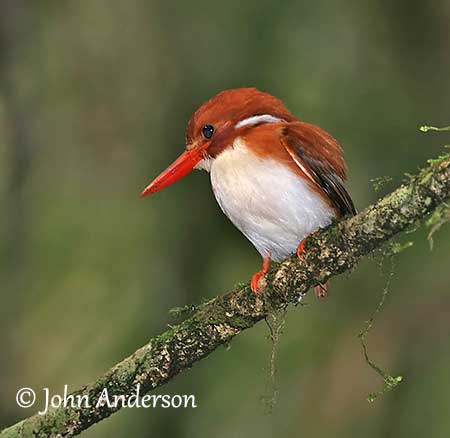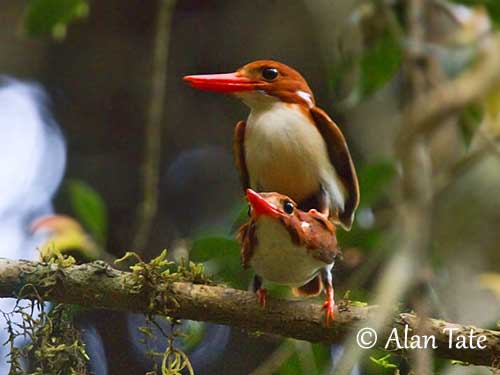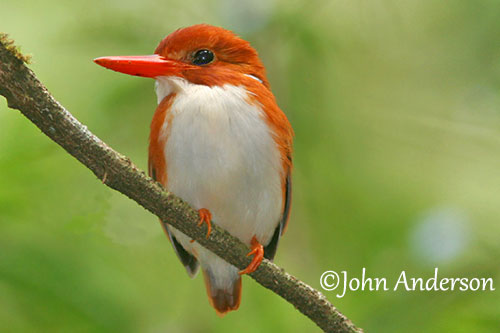
Fr: Martin-pêcheur malgache
Ang: Madagascar Pygmy-Kingfisher
All: Madagaskarzwergfischer
Esp: Martín Pigmeo Malgache
Ita: Martin pescatore pigmeo del Madagascar
Nd: Madagaskardwergijsvogel
Sd: rostvit kungsfiskare
Mal: tsakoko manga, Vintsiala, Vintsimena
Photographers:
John Anderson
John Anderson Photo Galleries
Alan & Ann Tate
AA Bird Photography
Text by Nicole Bouglouan
Sources :
HANDBOOK OF THE BIRDS OF THE WORLD Vol 6 by Josep del Hoyo-Andrew Elliott-Jordi Sargatal - Lynx Edicions, 2001 - ISBN: 848733430X
Wildlife of Madagascar par Ken Behrens,Keith Barnes - ISBN: 140088067X, 9781400880676 – Editeur: Princeton University Press, 2016
The Birds of Africa: Volume VIII: The Malagasy Region: Madagascar, Seychelles, Comoros, Mascarenes - Par Roger Safford, Frank Hawkins – ISBN: 1408190494, 9781408190494- Editeur: A&C Black, 2013
Kingfishers, Bee-eaters and Rollers Par C. Hilary Fry, Kathie Fry – Helm Identification Guides – Editeur: A&C Black, 2010 – ISBN: 1408134578, 9781408134573
Madamagazine - Small but a kingfisher
Phylogenetic relationships of the Madagascar Pygmy Kingfisher
RIVER KINGFISHERS Alcedininae – Don Robertson
Madagascar Pygmy-Kingfisher
Corythornis madagascariensis
Coraciiformes Order – Alcedinidae Family
INTRODUCTION:
The Madagascar Pygmy-Kingfisher is endemic to Madagascar. It has been placed in the SE Asian-Australasian genus “Ceyx” or in the African genus “Ispidina” in the past. But based on recent molecular studies, it is now placed within the African “Corythornis” lineage.
It frequents the western dry, deciduous forests, but it is not dependent on water. It is found throughout whole Madagascar, including in the highlands up to 1,200 metres of elevation.
The Madagascar Pygmy-Kingfisher is not globally threatened but the subspecies “dilutus” is rare and probably near extinction.
DESCRIPTION OF THE BIRD:
Biometrics:
Length: 13 cm
Weight: 17-22 g
The Madagascar Pygmy-Kingfisher adult has orange/bright rufous head and upperparts, with violet feather margins on nape and rump. We can see a white elongated spot on the neck side, towards the nape. On the wings, the primaries are black.
The underparts are white from chin to undertail-coverts, but body sides and flanks are rufous.
The long, vertically flattened bill is orange. The eyes are dark brown with buff lores. Short legs and feet are orange.
Male and female are similar.
The juvenile is duller, with reduced violet wash. The bill is black with pale tip.

SUBSPECIES AND RANGE:
The Madagascar Pygmy-Kingfisher has two subspecies.
C.m. madagascariensis is found in W, N and E Madagascar. It is absent from SW and far S.
C.m. dilutus occurs in the arid SW region of the island. This race is known from a single specimen in Zombitse forest in SW. It is paler than nominate and the violet tinge is absent.
HABITAT:
The Madagascar Pygmy-Kingfisher frequents mainly margins and interior of evergreen forests in E, N and NW, but it also occurs at some sites in the spiny forest region. It occurs widely below 1,000 metres, and rarely above 1,200 metres of elevation. The species is not dependent on water.
CALLS AND SONGS: SOUNDS BY XENO-CANTO
The Madagascar Pygmy-Kingfisher produces a single-note call, a high, strong and penetrating “tsip”. A high-pitched squeak can be heard too “treet treet”. If the bird is disturbed and while flying off, it gives high “chweip” or “treeee”.
BEHAVIOUR IN THE WILD:
The Madagascar Pygmy-Kingfisher feeds mainly on frogs and insects (grasshoppers, beetles, earwigs, ants and larvae), shrimps, and occasionally, but rarely, on small reptiles, involving no dependence on water.
It searches quietly for food perched on branches and watching the surrounding area. Once a prey is detected and located, it dives head first to catch it with the bill. Then, it kills the prey by beating it against a branch before to swallow it. It hunts from perches in the dense undergrowth, and returns to its perch with the prey.
At the beginning of the breeding season, the Madagascar Pygmy-Kingfisher male establishes and defends the territory.
The courtship behaviour of this species is currently unknown. However, we can suggest that like in numerous Alcedinidae species, aerial chases and advertising calls from several perches are part of pair formation.

Then, the pair shares the nest-building and excavates a long tunnel inside an earth bank. Courtship feeding may often occur during the nest-building and the pre-laying phase. The copulation may be preceded by courtship feeding from male to female. They are usually monogamous.
The Madagascar Pygmy-Kingfisher is sedentary on the island.
The flight is usually fast and direct.
REPRODUCTION OF THIS SPECIES:
The breeding season takes place between the rainy season in October and January, with the laying mainly in November/December.
Both mates build the nest together, a tunnel of 30-35 centimetres long and 5 centimetres in diameter, allowing only one bird at a time. The nest is often excavated in earth bank, at the edge of a forest trail.
The female lays 4 white eggs and both adults share the incubation. There is no information on incubation and fledging periods, but usually, the incubation lasts between two and four weeks depending on the species.
Because the nest is a narrow tunnel, only snakes and small lizards are able to enter and steal the eggs.
PROTECTION / THREATS / STATUS:
The Madagascar Pygmy-Kingfisher of nominate race is relatively common and widely distributed, whereas the race “dilutus” is rare and threatened by extinction.
However, the population trend is decreasing since several years, but it does not seem to be critical until now.
The Madagascar Pygmy-Kingfisher is currently evaluated as Least Concern.
